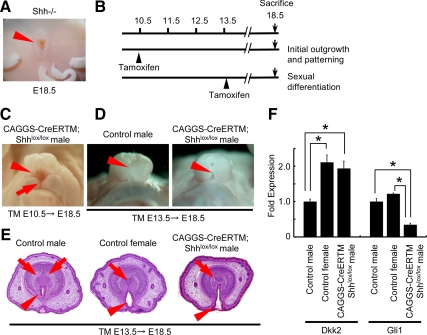Fig. 5.
Requirement of Shh in both initial development and sexual differentiation of the GT. A, The Shh null embryos show a GT agenesis and a persistent cloaca. B, TM treatment timeline; TM is treated at E10.5 or E13.5 to investigate the effect of Shh for the initial development and sexual differentiation of the GT, respectively. C, Conditional Shh KO embryos treated with TM at E10.5 display a severe lower (ventral) GT abnormality with a groove-like structure (arrowheads). An arrow indicates a cleft in the scrotal region. D and E, Male mutant embryos treated with TM at E13.5 display the abnormal masculinization phenotypes of the GT. Note the slit-like defect in the ventral midline of the mutant GT (D, arrowhead). The urethral fold is unfused, resulting in an impaired tubular urethra (E, arrowhead), and the prospective corporal body is underdeveloped (E, arrows). F, Dkk2 expression is increased, whereas Gli1 expression is decreased in the mutant male GT. The relative RNA equivalents for each sample were determined by standardization with ribosomal protein L8 levels. Statistical significance is indicated by asterisks, with P < 0.05.

